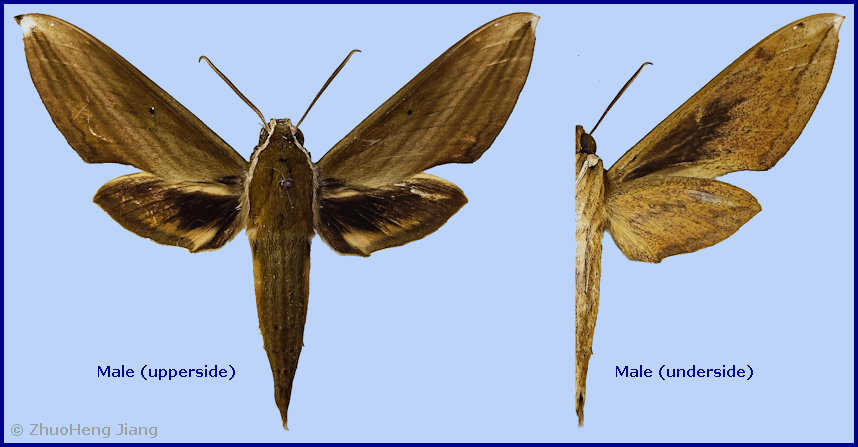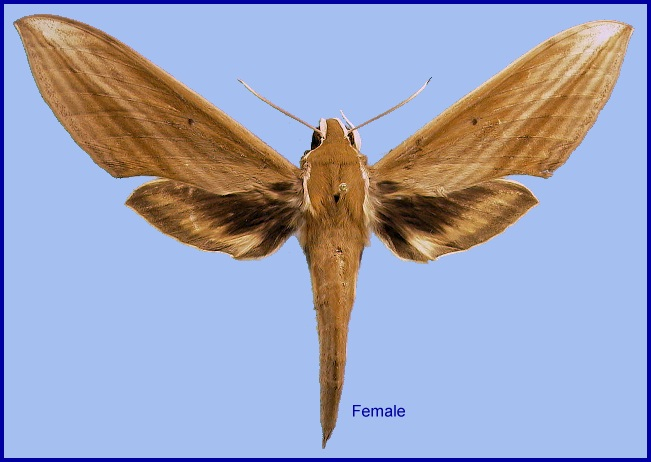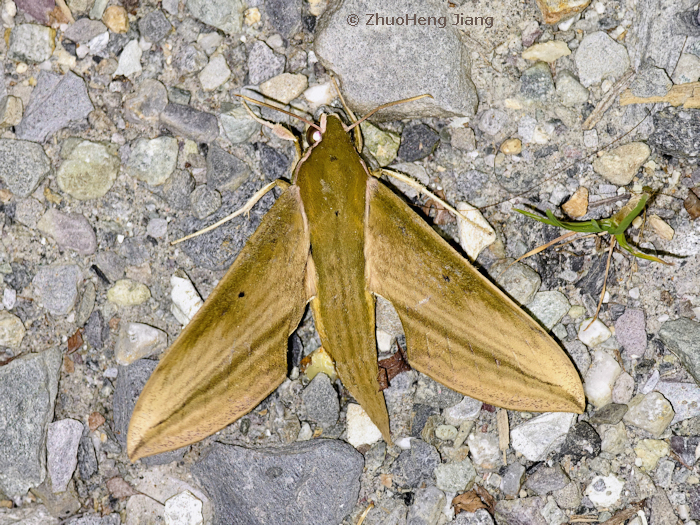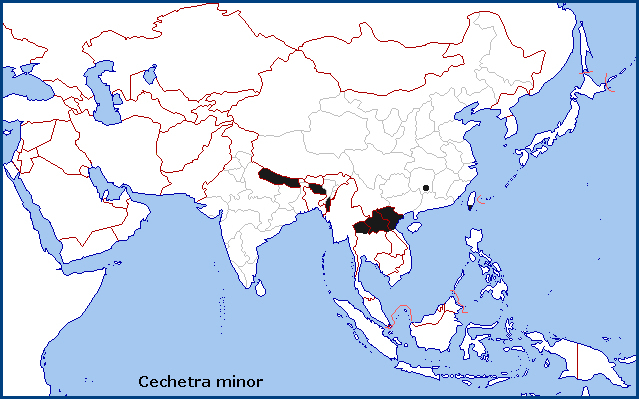

Chaerocampa [sic] minor Butler, 1875, Proc. zool. Soc. Lond. 1875: 249. Type locality: [India, Uttarakhand,] Massuri [Mussoorie].
Synonym. Chaerocampa minor Butler, 1875.
Synonym. Cechenena minor Rothschild & Jordan, 1903.
Synonym. Cechenena minor olivascens (Mell, 1922).
Note. Rothschild & Jordan (1903) synonymized Theretra striata Rothschild, 1894 with Cechenena minor (Butler, 1875), but gave no explanation or justification for doing so. Later, Zolotuhin & Ryabov (2012) moved all the more dainty species of Cechenena with a 'stripy' pattern into a new genus, namely Cechetra Zolotuhin & Ryabov, 2012, including Cechetra minor and its then synonym striata.
However, to quote Haxaire, Melichar & Giusti (2023) - "We had noted that throughout a large part of the range of Cechetra minor, insects of a smaller size and a much more contrasting pattern were collected fairly regularly, insects in which the fourth oblique transverse line on the forewing upperside was often very accentuated and the area between the second and third oblique transverse lines was much paler. Furthermore, many of these insects were generally lighter, with any darkening of the forewing limited to the costa. The apex of the wing was also often more prominent. The overall impression is of a slenderer and paler but more 'stripy' insect compared with C. minor. This observation had been made simultaneously by the first two authors, initially in particular in respect to the populations of C. minor in Laos and Thailand, then later for specimens from China. Examination of our respective collections then revealed the same pattern in Taiwan, Burma, and most recently in India, following expeditions undertaken by the second author. But it proved impossible to identify any constant and distinctive phenotypic character by which the two forms could be unequivocally distinguished; there were only general overall impressions. However, analysis of DNA barcodes removed any doubts that there were indeed two species that were apparently sympatric over most of their collective ranges. Our samples formed two very distinct clusters with a genetic distance between them of 4.46%, which is sufficient in subtribe Choerocampina to accept the two species that are already largely separable on habitus". Therefore they revalidated Cechetra striata as a good species and removed it as a synonym of Cechetra minor.
Although the adults are phenotypically very similar and sometimes impossible to tell apart, DNA barcode sequences clearly separate Cechetra minor (BIN BOLD:AAB7354) from Cechetra striata (BIN BOLD:AAB7355), by 4.46%. The separation is clear and the clusters are internally very homogeneous (Haxaire, Melichar & Giusti, 2023), indicating that the two taxa are not just refugial entities in the process of merging.
Wingspan: 90--98mm. Similar to small specimens of more uniformly patterned Cechetra lineosa, but immediately distinguishable by the lack of a pale median dorsal band along the thorax. Forewing upperside with full complement of seven postmedian lines. Seven lines present in distal half of the wing but line 6 short and completely merged with 7, which is generally blacker posteriorly and somewhat undulating. Forewing underside ground colour orange-beige. Head, thorax and abdomen olive-brown; upperside of thorax lacking a pale medial band. Dorsal lines of abdomen less prominent than in Cechetra lineosa. Outer midtibial spur generally equal to the inner, but sometimes longer or shorter.
In the male genitalia, gnathos less triangular at tip than in Cechetra lineosa. Harpe with large, asymmetrical stridulatory scales, proximal side of each enlarged, longitudinally folded or ribbed, darker than the distal side. Phallus almost symmetrical, apex rounded in dorsal view; the left process vestigial, with just a few teeth and no free projecting process; the right process somewhat widened at apically, dentate.
When compared with Cechetra striata, Cechetra minor has a thin harpe that is practically straight. In Cechetra striata the harpe is more slender, less wide basally and more curved apically. With regard to the uncus, gnathos and dorsal apical plate of the phallus, there were no clear diagnostic features (Haxaire, Melichar & Giusti, 2023).

Like Cechetra striata (Rothschild, 1894), a very nervous species, which will take flight on being disturbed or even if movement is detected nearby.
China: 1.viii (Yunnan). Taiwan: Not recorded.
OVUM: Not described.
LARVA: Full-fed 85mm; width 11mm; horn 8mm. In the first instar, pale yellow with a long black horn. In the second instar, green with a long straight black horn. By the third instar, a very faint pale dorso-lateral stripe appears. There is an eye-spot on segment 5, blue in front, yellow behind. Horn long, base reddish, tip pure white, rest black with black tubercles. In the fourth instar, head green, body paler green with transverse rows of yellowish dots. There is a narrow dark green dorsal stripe from segment 2 to base of horn, and a dorso-lateral stripe from 2 to base of horn which is very pale bluish-green edged above with dark green. Eye-spot with pupil blue in front, green behind, edged broadly with yellow and narrowly with dark blue. Horn long, straight, cylindrical, thick at base and tapering evenly to a point, its surface shiny, basal half degraded reddish-brown becoming gradually darker, tip narrowly white (Bell & Scott, 1937).
In the fifth instar, very similar to that of Cechetra lineosa, but much paler. Head dull and smooth. Body dull and smooth. Eye-spot shiny as though enamelled; segment 5 swollen and both 4 and 5 somewhat dilated ventro-laterally. Horn of medium length, slightly flattened laterally, tapering slightly to a blunt point, down-curved; surface shiny and covered with bluntly pointed tubercles.
In colour, head brown dotted with paler brown. Body dorsal area coloured like the head, lateral area pinkish. There is a narrow black dorsal stripe on 2 to 5, and a broader dorso-lateral stripe from 2 to base of horn, this pale brown on anterior segments, nearly white on posterior segments, broken by the eye-spot on 5 and edged above with dark brown. Eye-spot with pupil deep indigo-blue dotted with yellow in the posterior half, edged narrowly with yellow and still more narrowly with black. There is a round whitish subdorsal spot in the posterior half of each of segments 6 to 11. Oblique lateral stripes are present on 6 to 10, these pale pink edged above with dark brown which shades into the body colour. These stripes reach the dorso-lateral stripe, that on 10 running across 11 and 12 to base of horn. Horn brown; legs reddish. Spiracles pink with a-brown suffusion on each side of the slit (Bell & Scott, 1937).
PUPA: 56mm; width 12mm. Head, thorax and wing-case dark brown. Broad dorsal stripe paler brown; tubercles on wing-case black; abdomen with a dark brown dorsal stripe, and a broader degraded ochreous stripe on each side of it. Lateral area dark grey with short whitish stripes. Spiracles black, those on segments 6 to 12 lying on a larger black patch; cremaster black. Tongue-case projecting considerably frontad (6mm), but not so much as in Cechetra lineosa. Antenna slightly longer than fore leg, which reaches to beyond middle of wing-ease; mid-leg to three-quarters length of wing-case. Surface dull, head and thorax slightly shagreened; wing-case with lines of pointed tubercles along the veins. Cremaster nearly equilaterally triangular, tip squarely truncate; a long thin spine at each lateral angle of the truncation and a short spine midway between them, all straight and pointing directly backward. From the base of each of the longer spines a spine of equal length, bifid at the tip, projects directly outwards; a dorso-lateral spine with three or four points near base; all the spines polished and shiny. Upperside of cremaster rugose, underside deeply hollowed (Bell & Scott, 1937).
Pupae obtained in the Khasi Hills of India were similar to the above, except for the cremaster in which the long terminal spines were curved inwards instead of being straight, and the dorso-lateral spine was replaced by a simple steel-blue pointed spine. The cremaster of the pupae obtained by Mell in southern China agrees with that of those from the Khasi Hills. The difference may be individual or may point to the existence of two subspecies (Bell & Scott, 1937). These may have been of Cechetra striata (Rothschild, 1894).
Larval hostplants. In India on Saurauia pundiana, Vitis and Amorphophallus (Bell & Scott, 1937).
None recorded.
China: Yunnan (Weixi Lisu Autonomous County; Yuanjiang Hani, Yi and Dai Autonomous County); Xizang/Tibet; Guizhou; Hunan.
Taiwan: Kaohsiung Hsien; Taipei Hsien (Wulai); Nantou Hsien (Lushan Spa); Hualien Hsien (Hungyeh).
There are confirmed records from northern India (Meghalaya, Mizoram), Nepal, Thailand, Laos, Vietnam, China (Yunnan and Hunan) and southern Taiwan, but not Japan (Haxaire, Melichar & Giusti, 2023).

 Return to Sphingidae of the Eastern Palaearctic species list
Return to Sphingidae of the Eastern Palaearctic species list